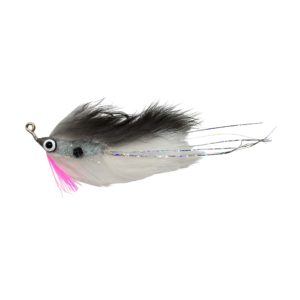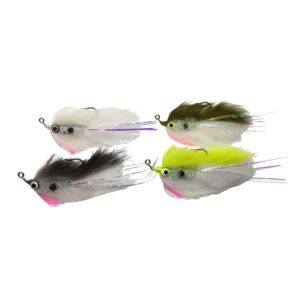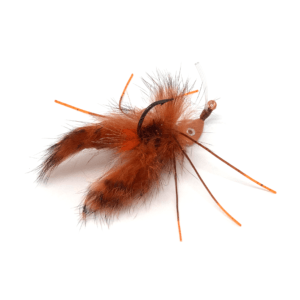Ratic Shad Buggs
-
Sale!
Ratic Shad Bugg
$4.95 Select options This product has multiple variants. The options may be chosen on the product page
A series of very interesting conversations led to the creation of our first striped bass lure: the Ratic Shad Bugg. A customer from the Atlanta area introduced me to Henry Cowen, a fly fishing and light tackle guide who specializes in striped bass. Henry told me that when striped bass are chasing small shad, fly fishermen outfish conventional fishermen. It’s because they can more closely match the hatch and keep the fly near the surface where the fish are busting the shad. Then he told me about a fly that darted back and forth like a wounded baitfish and stayed near the surface. Lastly he sent me pictures of the shad and a fly he designed to imitate them.
I was off to the races after that, and several months later sent him some Ratic Shad Buggs to fish. They worked just like they were supposed to, and since then have been fooling striped bass and lots of other gamefish in both freshwater and saltwater. And that’s how we’ll break down the advice and fishing tips that follow. But first, come general information.
Ratic Shad Buggs come in two sizes, 2.5” and 3”. The weight is located near the back of the lure, and that’s what gives them the darting action. When wet the 2.5” version weighs 1/4 oz. and the 3” version weighs 3/8 oz. They’re meant to work like a topwater, with a twitching retrieve. They dart back and forth when you work them this way, and this action is deadly. On the pause they fall slowly, evenly, and with lots of action. Fish will often hit them on the fall as well so hang on! The action comes from the rabbit strips on the top, back of the lure, and the belly. In the middle you have flash and the spot behind the eye, just like the real thing. Trailing the bait is a material called flashabou that gives the lure even more action.
Freshwater Striped Bass
Shad are a major food source for striped bass in large freshwater lakes and reservoirs. When they’re chasing them near the surface, Ratic Shad Buggs are deadly striped bass lures. Match the hatch depending on the size of the bait, and vary the retrieve depending on what the fish like that day. Three of the most popular colors for freshwater striped bass are, starting on the left: Gray Ghost, Key Lime, and Chained Beast.
Saltwater Striped Bass
Menhaden are a favorite food of striped bass in their saltwater range along the East Coast. Ratic Shad Buggs imitate the juvenile form of this baitfish, often referred to as Peanut Bunker, very effectively.
Ratic Shad Buggs also imitate herring, another important bait for striped bass. Again, match the hatch depending on the size of the bait. If they’re chasing bait near the surface work the lure more quickly, and if they’re deeper then let the lure sink before you start reeling. Again, they might hit it when it’s sinking! The three most popular colors of striped bass lures for saltwater are, starting on the left: Chained Beast, Gray Ghost, and Ghost.
Beastie Buggs
-
Beastie Bugg
$9.49 – $35.95 Select options This product has multiple variants. The options may be chosen on the product page
Beastie Buggs are crab imitations, available in three sizes: 1/8 oz., 1/4 oz. and 3/8 oz. These Buggs imitate the crabs that striped bass feed on when they’re cruising the flats. They will sit on the bottom and look alive, and have lots of action when you swim them in short hops or scoot them across the bottom. For saltwater, the most popular colors of striped bass lures are, starting on the left: Blue Crab, Backcountry, and Natural.
More in the Hopper More in the Hopper
For several years I’ve been tying prototypes for striped bass fishermen. They’ve been successful fishing several different eel imitations, and I’ve recently been sending customers with heavier versions of the Hydra Bugg swim jigs. A heavier version of this jig would be useful for lots of different species and I hope to make it happen soon.


